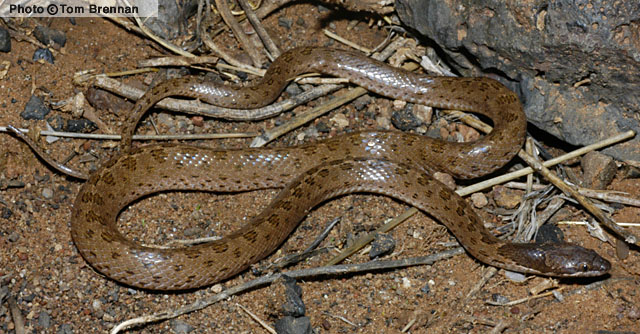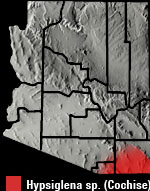Online Field Guide to The Reptiles and Amphibians of Arizona



Cochise County, AZ
| HOODED NIGHTSNAKE Hypsiglena sp. nov. |
Mildly-Venomous
|
|
DESCRIPTION: A small (up to about 600 mm or 23″ in total length) gray, or tan snake with two rows of small, dark, gray-brown blotches on the back (dorsal blotches). The neck is marked with a broad collar which is composed of a single blotch that is rounded on the back edge. A mid-dorsal line extends anteriorly from the front edge of the collar. A dark DISTRIBUTION: This snake is distributed across most of Cochise County, Santa Cruz County, and southeastern Pima County at elevations ranging from about 3,000′ to about 8,500′. HABITAT: The Hooded Nightsnake is found in biotic communities ranging from Sonoran Desertscrub, through the grasslands, and woodlands, and into cool Petran Montane Conifer Forest. It is found in an equally wide variety of terrain types ranging from flat, open, desert to steep, rocky, wooded slopes. It seems to be most abundant in moderate terrain within desertscrub and Semidesert Grassland communities. BEHAVIOR: This strictly nocturnal snake hibernates during the cold months of late fall and winter. It is often encountered on remote roadways at night. It is mildly venomous but rarely bites when captured and its venom is not considered to be dangerous to humans. DIET: The Hooded Nightsnake uses mild venom injected by enlarged teeth in the rear upper jaw to subdue lizards and small snakes. It also eats reptile eggs, frogs, and a variety of insects. REPRODUCTION: Mating probably takes place in spring and a clutch of up to about 9 eggs is laid in spring or summer. REMARKS: This newly discovered species has not yet been named (Mulcahy 2008). Bartlett. 2000. Snakes of North America: Western Brennan, T. C., and A. T. Holycross. 2006. A Field Guide to Amphibians and Reptiles in Arizona. Arizona Game and Fish Department. Phoenix, AZ Brennan, T. C., and A. T. Holycross. 2005. A Field Guide to Amphibians and Reptiles of Maricopa County. Arizona Game and Fish Department. Phoenix, AZ Degenhardt, W. G., Painter, C. W., and Price, A. H.. 1996. Amphibians and Reptiles of New Mexico. University of New Mexico Press. Albuquerque. Fowlie. 1965. The Snakes of Arizona. Azul Quinta Press, Fallbrook, California Lowe, Schwalbe, Johnson. 1986. The Venomous Reptiles of Arizona. Nongame Branch Mulcahy, D.G. 2008. Phylogeography and species boundaries of the western North American Nightsnake (Hypsiglena torquata): Revisiting the species concept. Molecular Phylogenetics and Evolution. 46 1095-1115. Stebbins. 1985. Western Reptiles and Amphibians. Houghton Mifflin. New York, |
|
Visit Partners in Amphibian and Reptile Conservation:


HOME
Copyright © 2023, Arizona Game and Fish Department. All rights reserved.
If you make use of the textual contents of this site in reports, publications, etc. please cite and credit the author(s) and photographer(s). All photos on this website are copyrighted. However, those found in the species account section may be used for any noncommercial scientific, educational, or conservation purposes provided that photographs are not altered and continue to bear the copyright symbol and name of the photographer. Please contact the photographer regarding commercial use of copyrighted photographs.










